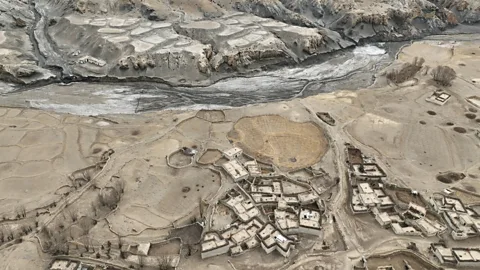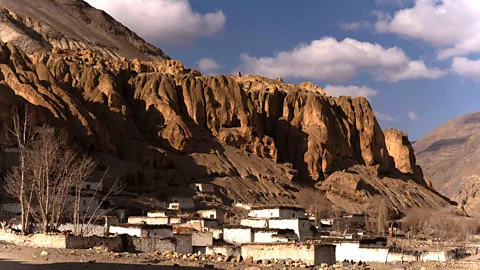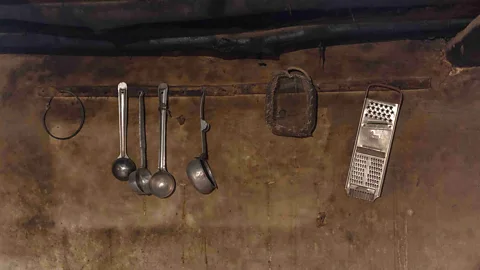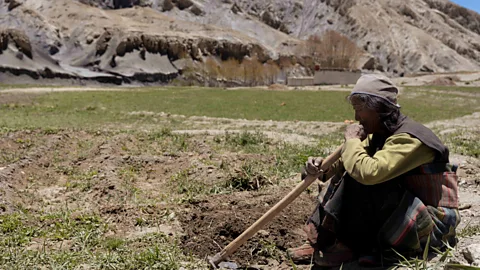 Shanta Nepali
Shanta Nepali
When prolonged drought struck the village of Samdzong, the residents had to make a critical decision: whether to stay or leave.
Bhakki Gurung's earliest childhood memory is of running around the vast, wind-swept valley in the remote and desolate borderlands of Nepal and Tibet. She remembers feeling very small, like a grain of sand, against the snowy peaks etched against cerulean-blue skies. At an altitude of 4,100m (13,451ft) in Upper Mustang, the winters were unforgiving, but during summer, she remembers the stream, its waters glistening with the flow of glacial melt.
"Our ancestors used to say that we have been moving from one place to another for ages in the region. Moving is what made us," says Gurung, who is now 70 years old. "At some point, we inhabited our village of Samdzong as well," she says.
For centuries, nomadic families have driven their livestock across northern Tibet's steppe, preserving a way of life that goes back generations. The inhabitants of Upper Mustang, who arrived some 3,000 years ago, originally came from the north and have their own unique indigenous culture, traditions, languages and practices. When they entered Mustang, they carved out caves into steep valley walls, now known as sky caves, and lived there. As time passed, they settled and built monasteries and mud houses, while engaging in the "salt economy" — trading Tibetan salt and wool across the central hills and the plains.
Nomadic pastoralists have been constantly exposed to the harsh climate of the Himalayas. Now, this region is regarded as ground zero for climate impacts.
For the people of Samdzong, migration has been the oldest survival trick, but now, they are facing a threat on an unprecedented scale. The village was first gripped by drought in the early 1990s, says Gurung. The glacier-fed stream was slowly vanishing. Faced with the harsh reality of climate change, they moved once more, journeying 10 miles (16km) away from their village, and leaving behind their ancestral land and cultural heritage in 2012.
The faceless enemy
The earth beneath much of Samdzong is not what it used to be. The irrigation channel that runs along an almost dry riverbed had no water to irrigate the land, exacerbating the farming challenges during dry spells, and leading to poor crop growth. Livestock were dying and locals were frustrated.
The region was also experiencing worsening rains during the summer. Suddenly, there was more water. In a trans-Himalayan region that receives less than 200mm (7.9in) of rain a year, erratic rain and snowfall can lead to a deepening water crisis. That means fewer rainy or snowfall days, but heavier precipitation on those days. The result is floods and droughts in the same place. And in a mountain village like Samdzong, these often come in the form of destructive flash floods.
 Tulsi Rauniyar
Tulsi Rauniyar
Experts have concluded that another event in 1988 was caused by heavy snowfall accompanied by relatively high temperatures, triggering a significant glacial lake outburst flood. The outburst overwhelmed four villages, toppling large boulders, crushing more than 36 houses, and sweeping away countless livestock, forcing families to move elsewhere. The landscape remains littered with debris and boulders, serving as a powerful reminder of the event.
Meanwhile, by the late 1990s, the drought was worsening, says Gurung. "I lost two of my newborns. We didn't have any means to get any form of help or medical treatment," she says. "It seemed like a faceless enemy had put a curse on our village. I prayed and prayed, to our gods and ancestors. But nothing worked."
Climate Guardians
This article in the Climate Guardians series was supported by funding from the European Journalism Centre, through the Solutions Journalism Accelerator. This fund is supported by the Bill & Melinda Gates Foundation.
There is no electricity, no hospital, police station or health centre in this remote corner of Nepal. Studies indicate that poverty rates in mountainous regions surpass those in other parts of the country, with many inhabitants eking out a living at subsistence levels. Because of this, and the fragile nature of pastures, extreme weather events are often disastrous in the Himalayas.
With heavy hearts, the village had to make a critical decision – whether to stay or leave.
Gurung recalls the day when the village had a group meeting that would decide the future of the village. In the summer of 2006, almost every villager reluctantly decided to leave their home. Despite many elders adamantly declaring they didn't want to leave their ancestral homes – the sole remnants of their history, memories and culture – due to concern for the future of the next generation, they didn't feel they had a choice.
"In the face of such obliteration, we needed to find alternative ways to think about our children's future. The choice was forced upon us," says Pasang Tsering, a local leader.
 Tulsi Rauniyar
Tulsi Rauniyar
The residents then requested permission from the then-king of Mustang to relocate to fertile land around seven miles (11km) away from the old village. Amid all this, in August of 1997, a monk from the nearby town of Lo Manthang was able to gain the support of Swiss photographer Manuel Bauer. Bauer helped the villagers relocate by raising funds through lectures in Switzerland.
By 2016, 17 households consisting of 86 residents had been relocated from Samdzong to a new settlement they named "Namashung", meaning green meadow. The villagers were happy to move closer to the city of Lo Manthang, once the capital of the Kingdom of Lo, hoping it would bring them economic prosperity.
The cost of moving a village
It took more than five years to build Namashung. It began with the task of clearing away bulky boulders – the remnants of the 1988 glacial lake flood. The allocation was made by dividing the available areas into equal surfaces that were distributed through a lottery system. Local resources like soil and lime became the building blocks of the villagers' new homes, while essential materials such as nails, locks and glass were sourced from regional markets. The villagers dismantled the furniture in their existing houses to reuse the wooden elements for constructing new houses in Namashung due to the lack of wood in the area. Most of the construction work was done by the family members with the help of relatives and friends, in exchange for other workmanship.
Back in the old village, houses still stand dusted brown with sand. Just five villagers still live in Samdzong. Sixty-five-year-old Tinzen Angmu is one of them. "We used to harvest mustard, buckwheat, and wheat twice a year," she says, tilling the soil. Since there is not enough water now, they only grow wheat once a year, and it is not enough for even five people. Their relatives who have moved away provide them with the food they are unable to grow themselves.
"We are only five people here, too old to leave and start over at the new village. This is our only home," she says. "It is all right here. Except for the emptiness…it's scary sometimes."
And yet, Gurung and the other villagers long for fragments of the past, such as the monasteries, houses and sky caves, which remain irreplaceable.
In the face of such obliteration, we needed to find alternative ways to think about our children's future. The choice was forced upon us – Pasan Tsering
Nor have all challenges of the resettlement been resolved, says Tsering, the local leader in Namashung. The residents must share their water source with the neighbouring village of Nenyol. The latter community expresses concern that the water supply is already scarce. Meanwhile, the residents of Namashung are still without secure land ownership rights as they await approval from the former royal family.
Pasang Dolma Sherpa from the Center for Indigenous Peoples' Research and Development, a non-profit dedicated to advancing the rights of indigenous people in Nepal, says that ensuring land rights for vulnerable communities like Samdzong is crucial. Without such rights, they are susceptible to expulsion, marginalisation and discrimination. She stresses that the local government needs to validate the process and issue land ownership certificates after the villagers have moved to formalise the resettlement.
The local government did not respond to BBC Future Planet's request for comment at the time of publication.

 Tulsi Rauniyar
Tulsi Rauniyar
Even with the new ground gained, it seems that the locals will have to come to terms with the fact that they are at risk of losing much of their material heritage. Their historic monasteries and sky caves are threatened by the climate crisis.
In Mustang, increasing rainfall has destabilised the earthen architecture. Stronger winds, humidity, and higher temperatures have already taken a toll on 15th-Century monasteries, their once white-coloured walls faded to a pale grey. In some areas of Mustang,local people are saving Nepal's crumbling monasteries elsewhere in Mustang. In Samdzong , this culture is also at risk. The village's caves, meanwhile, contain elaborate burials and shed light on the pre-Buddhist history of the Himalayas.
"We have simply accepted the loss of our beloved houses and monasteries," says Tsering. "In our village, there is no one with leadership traits present. We are herders and pastoralists, we did not receive any education. This is how we have lived for centuries."
Climate change-induced migration is happening across Nepal, and the case of Samdzong can be seen as emblematic of a larger trend facing many Himalayan communities. Neighbouring village of Dhye has transferred the whole settlements to a place with more fertile and secured lands at the cost of their history, memories and traditions of the past. Another village Yara also faces the eventuality of having to move.

 Tulsi Rauniyar
Tulsi Rauniyar
In Nuwakot in central Nepal, almost the entire population gradually migrated over time due to water scarcity concerns. Similarly, in another district of Ramechhap, a fisherman community moved abruptly as their river dried up, others decided to wait. People migrated to lower elevations to meet basic needs and find better livelihoods, leading to internal conflicts within households.
"The feasibility of staying in rural areas has become increasingly challenging," says Amina Maharjan, a senior specialist for livelihood and migration at the International Centre for Integrated Mountain Development in Patan, Nepal. "While Samdzong was able to relocate through international support, both Nuwakot and Ramechhap find themselves unable to access international or government assistance."
"Most of these climate-vulnerable populations are retreating from stress areas to new areas on their own initiatives with little to no government support. The burden of adaptation is solely on the vulnerable population", she says.
Samdzong is just one example, says Maharjan. "This ongoing migration is palpable. We've witnessed countless individuals escaping parched regions across the rural livelihoods that are no longer viable," she says. "The global migrant population has almost increased significantly in the last decade, highlighting the pressing concern of addressing the escalating numbers of displaced individuals. The climate crisis will make many high-risk areas unhabitable, forcing people to relocate."
We are too old to leave and start over at the new village. This is our only home – Tinzen Angmu
The temperatures in Upper Mustang are expected to rise 6C to 10C in winter and 4C to 10C during the monsoon period by the end of the 21st Century.
Many fear the worst is yet to come for the wider region. The ice and snow held in the mountains of the Hindu Kush Himalayas (HKH) provide freshwater for two billion people in Asia. According to a 2023 study, glaciers in the HKH could lose up to 80% of their current volume by 2100. From Afghanistan, to India and Pakistan, rural villagers are experiencing the combination of long-term crippling drought and the disappearance of the glaciers that used to provide meltwater for irrigation.
Dharam Uprety, a climate resilience specialist and researcher at Tribhuwan University in Kirtipur, Nepal, says that globally, communities residing in close proximity to nature, particularly those who depend on natural resources for their livelihoods, are among the first to observe shifts such as rising temperatures, erratic precipitation, changes in seasonal patterns, altered migration routes, intensified wind and waves, diminishing glaciers, droughts and rising water levels.
"But what were once minor and somewhat concerning changes have now escalated to extreme levels, resulting in a multitude of unprecedented and enduring disasters for the most vulnerable and fragile human communities worldwide," says Uprety.

 Shanta Nepali
Shanta Nepali
This winter it didn't snow at all in Mustang, the villagers tell me. They are now bracing themselves for the notoriously dry season, worried that their already tenuous water supply may dwindle further.
Back in Samdzong, the village was quiet; no bleating livestock or children running around the vast expanse of the arid landscape. Only the occasional clatter of rocks or debris being churned up by the wind broke the silence.
Gurung walks silently in the familiar patch of dried grass in front of her old house in Samdzong where she spent her childhood. When asked what the future looks like for her and her community, Gurung looks down and says: "Our land holds our history, and our history breathes life into our existence. With our ancestral land, our very foundation, at risk, our lives are at constant risk."
--
For essential climate news and hopeful developments to your inbox, sign up to the Future Earth newsletter, while The Essential List delivers a handpicked selection of features and insights.